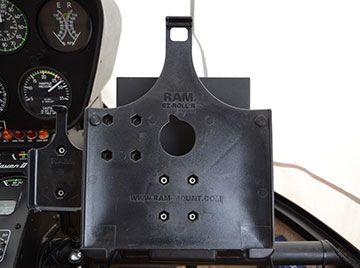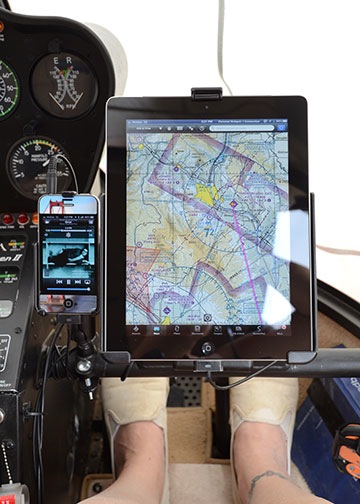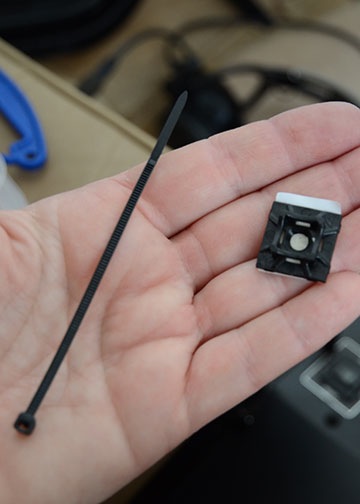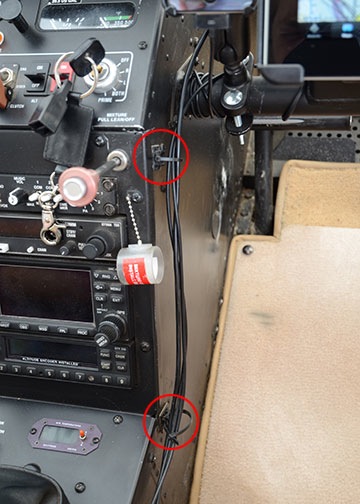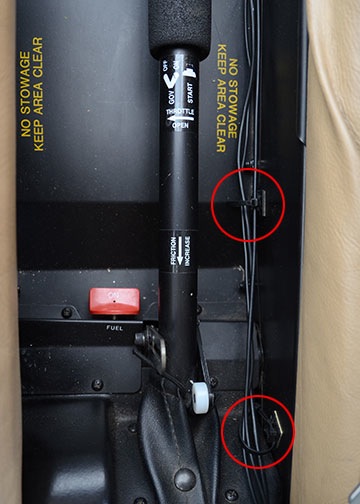As a ghost from my past used to say, any job is easy when you have the right tools.
One of the things that has been frustrating me lately in my jewelry-making endeavors is my inability to fine-tune the stones I acquire so they better meet my standards. For example, I bought a bunch of cabochons from a dealer in India and they all arrived with unpolished backs. While that’s acceptable if you plan to set the stones with something behind them, I don’t. I want the entire stone polished.
So I tracked down a local lapidary, Gary, who does it as a sort of retirement hobby. He polished the backs of the stones and charged me a nominal fee. It was neat to watch him do it on his cab making machine. But when I got another set of stones from another dealer and realized how much work they’d need to be usable, I realized that I’d soon become a nuisance to Gary.
Add to that a load of local petrified wood and obsidian that an orchard-owning friend of mine, Donn, was trying to unload. As is, no one would touch them — and I must have asked a half-dozen rock people. But with a little cutting and polishing, they might be salable — or at least usable in the jewelry I make.
And, of course, I was making fused glass cabochons in my kiln from repurposed wine bottles and they needed polishing to make them usable.
So it made sense to buy a cab machine.
At least that’s what I told myself.
It was a big expenditure and I sat on the fence for a few weeks before pulling the trigger. I needed a birthday present, I reasoned. There were only two things in the running: an inflatable Hobie pedal kayak that could accept a sail kit — yes, they do make things like that these days — or the CabKing 6 cabbing machine. Believe it or not, the CabKing was about $1,000 cheaper. I reasoned that I could use it for my jewelry business and, thus, write it off. That would reduce the cost by my current year tax rate — as if that really mattered. The fact that I needed a birthday present was enough to get me to buy it. (Maybe I’ll get that kayak next year.)
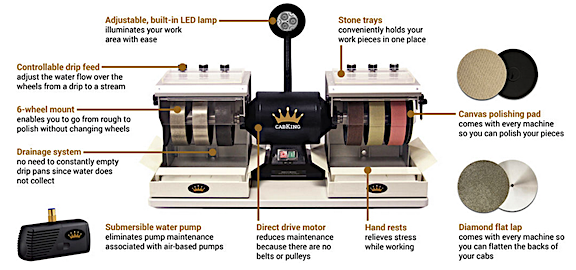
The CabKing has 6 grinding/polishing wheels and other features that make it a great tool for making cabochons.
I should mention here that a lapidary friend of mine that I know from Quartzsite, AZ, John, told me not to buy the CabKing. He’s a Diamond Pacific dealer and that’s what he uses. He told me he could get me a deal on a comparable Diamond Pacific machine that had only been used about 10 hours in one of the stone-cutting classes he leads. But even with the discount, the machine would cost about $500 more. And I really liked the way the CabKing handled the water used to cool the stones as you grind and polish: it always puts fresh water on the wheels so there’s no chance of contamination from earlier stages in the grinding/polishing process.
Gary said the CabKing was a good machine but it had a tendency to splash a lot of water.
It came last week. So did some stones for tumbling and polishing. I played around with it. I was surprised about how easy it was to use to shape stones.
I had some trouble getting fine scratches out of my finished stones. I attended YouTube University for about an hour or two and watched a bunch of cab-making videos, including this good one. I soon realized that the scratches had to come out very early in the process — on my machine, by the time I’d run the stone through the third wheel, a 280-grit diamond resin pre-polish wheel. I took the stones back down to my shop and reworked them. The results were very satisfactory.
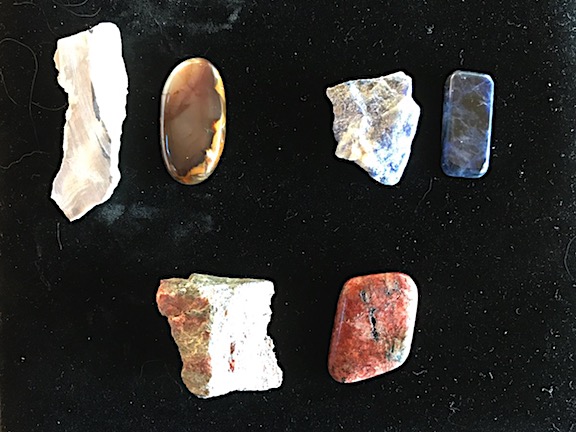
This is the first batch of stones I polished: petrified wood, sodalite, and a mystery stone I got from a friend’s garden.
I found that the petrified wood I’d gotten from Donn polished up beautifully.
Yesterday evening, I gave it another go with five pieces of stone: rose quartz, hawk’s eye, local obsidian, local petrified wood, fused wine bottle glass. In the afternoon, the driveway in front of my shop is in the shade and, with a nice little breeze blowing, it can be quite cool, even if it’s hot in the sun. So I wheeled the machine out — I installed it on one of the many wheeled carts I have accumulated — put a stool in front of it, and got to work. Two hours later, I had five decent cabochons.
To show them off better, I made a little video this morning. Check it out:
I’m learning a lot about stones and how the hardness affects how easy they are to cut and polish. The hawk’s eye is a mix of soft (tan) and hard (dark gray) stone and I have to be careful not to press too hard on the soft side. It doesn’t polish very well. The rose quartz and petrified wood polish very nicely. The obsidian had imperfections that turned into pits in the finished surface. And the glass polishes nicely, although fuse lines in the glass appear almost as cracks in the finished piece.
I’m starting to wonder what basalt, which we have no shortage of here, would look like polished. (You can bet I’m going to try it.)
I bought some slabs of outback jasper, bumble bee jasper, and moss agate to work with. I figure that each of these small slabs should yield 2 to 3 cabochons. The bumble bee jasper, which is a soft stone, is pitted and I’ll likely try stabilizing it before cutting and polishing it. I’m hoping that process fills the pits with a clear epoxy that’ll make it possible to get a good polish. We’ll see.
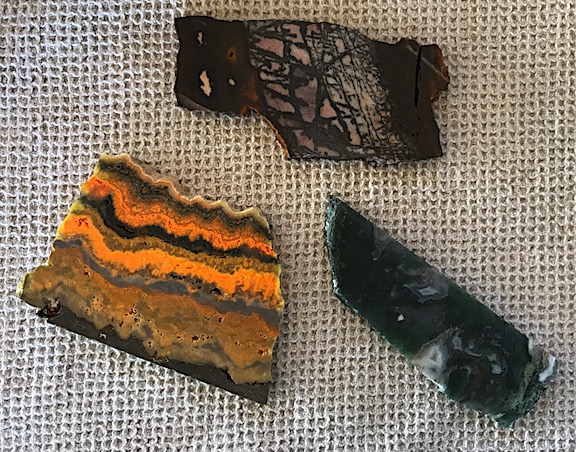
I bought these three slabs to try to make cabochons. I’m just hoping that my tile cutter can cut them into pieces without breaking them.
I think what I like most about this is how much I’ve learned about stones and lapidary work since January. (Yes, it’s just been since January that this became my latest hobby-gone-wild.) I love being creative in ways other than with words. I love being able to share nature’s beauty in a way that people can appreciate. And it’s nice getting paid to make the things I make.

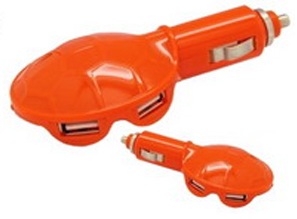 Next came “the turtle.” My friend Don recommended it to me and that’s what he called it. It’s actually a
Next came “the turtle.” My friend Don recommended it to me and that’s what he called it. It’s actually a  I found the solution on Amazon.com: the Mediabridge High Output Dual USB Car Charger for iPad and iPhone. [Sorry, but as of 30-August-20 this product is no longer listed on Amazon.] This device takes input from 12v to 24v and outputs a total of 3.1 amps: 1 amp on one USB port and 2.1 amps on the other USB port.
I found the solution on Amazon.com: the Mediabridge High Output Dual USB Car Charger for iPad and iPhone. [Sorry, but as of 30-August-20 this product is no longer listed on Amazon.] This device takes input from 12v to 24v and outputs a total of 3.1 amps: 1 amp on one USB port and 2.1 amps on the other USB port. I coupled that with a pair of
I coupled that with a pair of 